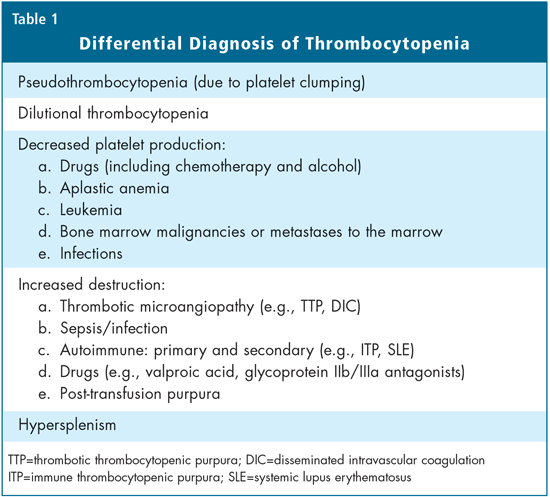Meeting the Challenge of Heparin-induced Thrombocytopenia
Jeff Silverman, MD, FRCPC, Fellow in Adult Hematology, University of Toronto, Toronto, ON.
William Geerts, MD, FRCPC, Consultant in Clinical Thromboembolism, Sunnybrook and Women's College Health Sciences Centre, University of Toronto, Toronto, ON.
Introduction
Thrombocytopenia, defined as a platelet count of less than 150 x 109/L, is an important clinical problem most commonly encountered in hospitalized patients. Although the differential diagnosis is extensive (Table 1), it is essential to always consider heparin-induced thrombocytopenia (HIT) in patients with thrombocytopenia who are hospitalized or who have recently been in a hospital.1,2
HIT is an adverse drug reaction induced by exposure to heparin that is followed by thrombocytopenia, platelet activation and a dramatic increase in thrombosis risk. Although it is one of the most common and serious drug reactions in hospitalized patients, HIT is frequently not recognized until a major thromboembolic complication has resulted. However, if diagnosed and treated promptly, the outcome is generally favourable. With the widespread use of heparin in the elderly, geriatric patients constitute the largest population at risk of developing HIT. Therefore, clinicians providing care for the elderly must be able to recognize and manage HIT effectively and efficiently.

Pathogenesis
Heparin is associated with two types of thrombocytopenia. Occasionally, heparin binds to platelets directly, leading to a mild thrombocytopenia often within minutes of a bolus dose. This process, termed "non-immune heparin-associated thrombocytopenia", does not progress despite continuation of heparin, and is mild, transient and clinically benign. The platelet count will rapidly normalize, and no intervention is required.3
In contrast, immune-mediated HIT is the most frequent immune drug reaction seen in hospitalized patients.1,3 Susceptible patients develop IgG antibodies against the complex of heparin and an endogenous protein called platelet factor 4 (PF4) that is found on the platelet surface. The HIT antibody, when bound to the heparin-PF4 complex, concomitantly binds to receptors on the surface of platelets, monocytes and endothelial cells, resulting in their activation.3,4 This has several important consequences. Firstly, platelet activation releases procoagulant platelet microparticles while monocyte activation causes the expression of tissue factor; both responses activate the coagulation cascade, resulting in thrombus formation. Secondly, activated endothelial cells promote platelet binding.4 Thirdly, activated platelets release more PF4 into circulation, which binds to and neutralizes heparin, thus inhibiting its anticoagulant properties and allowing the clotting process to extend.3 Finally, the binding of the HIT antibody to platelets also leads to their removal from circulation,4 resulting in thrombocytopenia which is associated paradoxically with thrombosis.
Frequency
HIT occurs in 1-3% of patients exposed to heparin for at least five days,5 and is more likely to occur with full-dose heparin given intravenously than with lower, prophylactic doses. However, even tiny doses of heparin, such as those found in line flushes or heparin-coated catheters, may occasionally produce HIT.
HIT is uncommon after exposure to low molecular weight heparin (LMWH) because the shorter chain length of LMWH is less able to form a complex with PF4.3,5 Furthermore, LMWH is less susceptible to neutralization by the increased PF4 released by activated platelets. In a study assessing the frequency of HIT antibody formation, the rate of detectable HIT antibodies was 8% for patients given unfractionated heparin versus 2% for those who received LMWH.5
Despite advances in understanding the pathogenesis of HIT, it is still unclear why only a small fraction of patients receiving heparin develop the HIT antibody. Equally puzzling is the observation that only some patients who produce the HIT antibody develop thrombocytopenia, and even fewer still suffer thromboembolic complications.3 Unfortunately, it is not currently possible to predict which patients will develop HIT or

